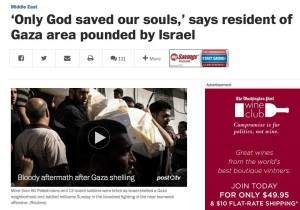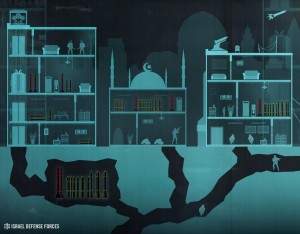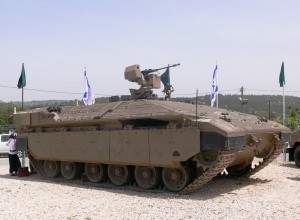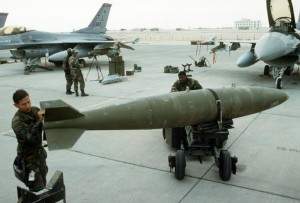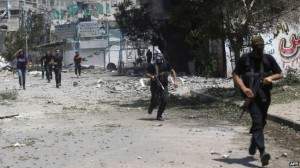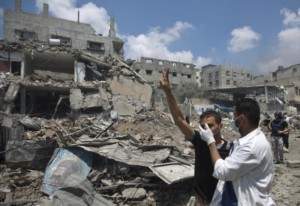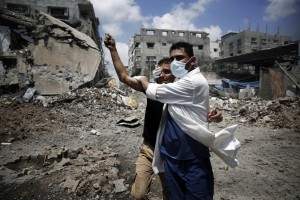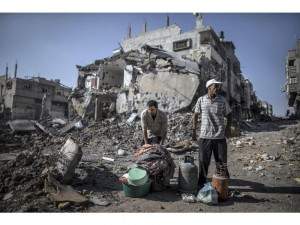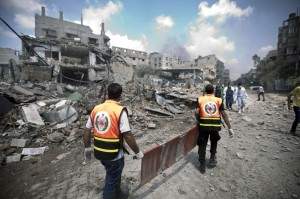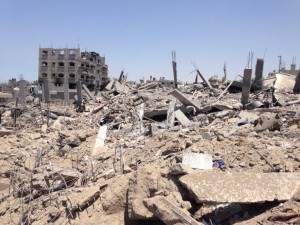A case study of media malpractice
August 12, 2023 by Thomas Wictor
On July 20-23, 2014, the Israeli Defense Forces assaulted the Gaza City neighborhood of Shijaiyah (also spelled Shejaiya, Shejaiyya, Shuja’iyya, Shijaiyeh, Shujayya, Shuja’ia, Shuja’iya, and Sajaiyeh). The reporting on this military action is one of the most exceptional examples of media malpractice I’ve ever seen. Not only was the purpose of the assault concealed, vital information was omitted, and the results were deliberately taken out of context so that public perception would be a precise inversion of what actually happened. I’ll tell you the undistorted, objective truth.
Even though I’m admittedly biased.
How the assault is portrayed
The Gaza City neighborhood of Shijaiyah has about 100,000 residents. Keep that number in mind. Almost every news story emphasizes civilian casualties while presenting only a perfunctory explanation for why the assault was carried out. Here’s a typical example, from the Washington Post.
After a few hundred yards, Shijaiyah’s main boulevard became impassable for vehicles because of shredded trees and downed power lines. House after house showed signs of heavy damage and raging fires from sustained shelling by tanks and artillery.
[Photos: Harrowing images from Shijaiyah]
Shattered glass and household belongings — a stuffed animal, a pair of undershorts, a bag of mangos — were strewn on the sidewalks. Charred automobiles and at least two abandoned ambulances blocked the way.
The earliest responders found bodies in the streets…
Reporters who arrived in the midafternoon during the cease-fire, arranged by the Red Crescent humanitarian organization, witnessed chaotic scenes of ambulance drivers struggling to fill their bays with wounded. On one street, seven stretchers were carried out of the rubble in 10 minutes. Some of the injured looked near death. Armed militants dashed down the street, their faces covered by checkered scarves.
Israeli military officials said that Shijaiyah was an important and legitimate target — a stronghold for militants and a launchpad for constant rocket fire at Israel, with a dense urban population living atop a warren of tunnels used by militant wings of Hamas and Islamic Jihad.
Capt. Eytan Buchman, a spokesman for the Israel Defense Forces, said the assault on Shijaiyah was intended to destroy Hamas tunnels and was not part of an effort by Israeli troops to move into the urban core or reoccupy the Gaza Strip.
The district is less than a mile from the Israeli border, he said, and many of Hamas’s tunnels are that long. The militants, he added, were fighting back fiercely.
Sami Abu Zohri, a Hamas spokesman, called the Israeli offensive in Shijaiyah “a massacre against civilians and a war crime.” He promised that “it will not break the people’s will. The resistance will continue.”
In the early morning, thousands of panicked residents were fleeing the overcrowded community of shops and homes and heading into Gaza City.
“I saw dead and injured on the street. I couldn’t help them. I couldn’t carry them. I had my arms full with my own children,” said Jalal Ghoula, an unemployed police officer who sat slumped in the shade of a brick wall outside the Shifa Hospital, Gaza’s largest medical center.
Those two brief paragraphs explaining why Shijaiyah was assaulted are repeated in article after article, with hardly any additional detail. The press is doing its best to obscure the reason that this dangerous operation was executed.
Prior to the battle
On July 15, the Israeli Defense Forces began warning the residents of Shijaiyah to leave.
By warning the civilians, the IDF put itself at risk, because it was also broadcasting to Hamas and Islamic Jihad that a ground assault was imminent. Here’s a translation of the leaflets dropped.
Israel also made automated calls and sent text messages warning residents to leave. The world press tells you that these warnings are of limited value because most Palestinians have nowhere to go.
Really?
If the Hamas government of Gaza wanted to save its civilians, it could easily ask the UN to create tent cities in the many opens spaces of the Strip. On the contrary, Hamas wants to get civilians killed, so it orders Palestinians to not leave their homes when warned.
The Hamas-run Palestinian Authority Interior Ministry said in a message to Gaza residents that the [Israeli] messages “are designed to weaken our resolve and to sow panic and fear among us, in light of the failures of our enemies. We call on Gaza residents not to pay attention to these messages and not to leave their homes.”
Therefore, although the 100,000 residents of Shijaiyah had five days’ notice, most of them stayed.
Shijaiyah as a Hamas stronghold
The IDF regards Shijaiyah as the “center of gravity” of Hamas’s military capabilities. The five days’ warning that the IDF gave Shijaiyah allowed Hamas and Islamic Jihad to prepare booby traps and ambushes.
Shejaiyya is in effect a military compound prepared for fighting, which is planted in the heart of the civilian population. All of the assets that are important for the terror organizations are there: welding workshops for manufacturing rockets, labs for making explosives, rocket warehouses, hidden rocket launchers, command centers, and a tunnel system that enables the terrorists to move between these facilities quickly without being concerned about getting hit from the air. There are also entrances to tunnels that lead into Israel.
Almost ten percent of the rockets fired at Israel since the beginning of Operation Protective Edge came from Shijaiyah. The IDF rightfully regards it as a fortress. They created a graphic to illustrate how Shijaiyah was a military installation completely and utterly merged with civilian residences and infrastructure.
Homes, mosques, schools, and hospitals are combat posts, weapons depots, and launching sites. When the attack began, there were nearly 100,000 civilians present.
The assault
Late on the night of July 19, 2014, the IDF began firing artillery barrages that landed on the outskirts of the city. This was to warn the civilians that the attack was imminent. The ground assault began around midnight, July 20. About 35,000 people then fled the city, leaving behind 65,000 or so. At around 1:00 a.m, Hamas and Palestinian Islamic Jihad carried out their ambush. Since the Israelis had not used artillery preparation, and this was Hamas’s center of gravity, it was the heaviest fighting of the war.
Lt Col Peter Lerner, a military spokesman, said the military met a “huge” level of resistance from Hamas militants in Shijaiyah, with anti-tank missiles, rocket-propelled grenades and automatic weapons fired from houses and buildings.
Haaretz has a detailed article about the fighting, but they’ve now put it behind a subscription wall. I’ll paraphrase.
Thirteen soldiers of the IDF Golani Brigade were killed in the fighting, seven when their armored personnel carrier (APC) was hit with an antitank missile. The infantry was under such heavy fire from all directions that they were ordered to get back inside their Namer APCs.
The Namer is the most heavily armored APC in the world. It’s a conversion of the Merkava main battle tank. After the soldiers in Shijaiyah remounted their Namers, Israeli artillery fired about 600 high-explosive shells as closely to the vehicles as possible, and jet fighters dropped 100 bombs. They hit within about 330 feet (100 meters) of the APCs.
Update
I originally wrote that the IDF dropped 1000-lb (453 kg) bombs, but they were actually 2000-lb (907 kg) MK-84 bombs.
This hair-raising gamble—going for broke the way the IDF had so often in the past—paid off; no more Israeli soldiers were killed. The shelling lasted twenty minutes, not all night. Tanks of the 188th Armored Brigade were sent in only after the Israeli infantry was stopped by the terrorist ambush. The IDF destroyed all the Hamas infrastructure in seven hours and then pulled out.
After spending an entire article describing the plight of Palestinian civilians, the New York Times finally admits what the IDF faced.
In Israel, the mood was grim but determined. The military, suffering its heaviest loss in a single day since the 2006 war in Lebanon, said seven of the 13 soldiers were killed when militants detonated an explosive device against their armored personnel carrier, three died in clashes with militants and three died trapped in a burning building.
The senior military official, who briefed reporters in Tel Aviv and spoke on the condition of anonymity in line with army rules, said the forces faced hundreds of Hamas fighters.
“It was a real battle there,” he said. “They were hiding in the apartments, shooting at the Israeli soldiers from the apartments, from the houses, from the windows.”
Hamas fired from every civilian structure it could. This is important to remember.
Aftermath and casualties
The press reported “widespread damage” in Shijaiyah. However, there seem to be an inordinate number of photos taken at one place.
My guess is that this is where the IDF troops went back into their Namers and sat out the danger-close artillery and aerial bombing. It’s almost certainly the hub of Hamas resistance. In the last image, note the perfectly intact buildings to the right. The windows still have glass in them! So much for the “flattened city” lie.
Much of the damage seems to be localized. I think this is part of the same battleground as the photos above. The buildings appear to be the same.
Here’s a recap: The IDF assaulted the most fortified strong point that Hamas had. It was located in the center of a neighborhood with 100,000 people. The IDF did not use artillery to prepare the battlefield, and no tanks or aircraft were included in the original plan. Hamas fire was so heavy that the Israelis had to get inside their APCs and call down artillery and air strikes on their own positions.
Do you know how many Palestinians died and were wounded in this massively ferocious operation?
Sixty-five Palestinians were reported killed, and 300 were wounded. You must reflect on that. The IDF plastered a neighborhood of 100,000 with artillery and aerial munitions, and then it attacked with tanks, APCs, and infantry, yet only sixty-five died. We know that Hamas lies about its casualties, so it’s a certainty that at least half of the dead were terrorists.
Considering that Hamas’s “center of gravity” was entirely interwoven with the civilian infrastructure, and 100,000 people were held captive at gunpoint, think how astonishing it is for the IDF to have destroyed Hamas’s fortress yet killed only sixty-five Palestinians. That means that the IDF literally considered each bullet it shot and munition it launched. There were terrorists in every window, but the IDF mostly held its fire.
All the articles out there say that local hospitals were “overwhelmed” by the 300 wounded from Shijaiyah. Gaza City has a population of about 516,000. Tucson, Arizona, has a population of about 524,000. In 2012 Tucson handled 2,033,600 emergency-room visits. That’s 5572 per night.
Are the hospitals in Gaza really being overwhelmed, or is that more fiction?
Here’s a Pallywood production about the “massacre” in Shijaiyah. Be warned that the young man is injured; he has a grotesquely broken leg. But everything else in this video is fake. You know how I know? Because the cameraman doesn’t help the young man. Also, as one “panicked” fellow sprints down the street, another group casually stands with their hands on their hips, staring.
The crone screams, and someone leans on a car horn, but that’s just to add drama. The “bullets” zipping by are phony. Those sounds were added in post-production. I can tell because they don’t hit anything, and neither the cameraman nor the injured young man show any urgency.
You can see from the many spent cartridge cases on the sidewalk that there was fighting, but it was long over by the time this crappy propaganda film was made.
The Battle of Shijaiyah was an anti-massacre. It was one of the most bloodless military operations in human history. Against inconceivable odds and fighting under spectacularly restrictive rules of engagement, the IDF went into a heavily populated residential area and destroyed its target while causing negligible civilian casualties. Sixty-five dead out of 100,000. The IDF were like surgeons removing a cancer that had metastasized throughout the patient’s entire body.
If you want to laugh at a pathetic buffoon, read the overwrought, childish, Opposite World prattling of British “journalist” Ben White: “Premeditated Murder: The Shuja’iyya Massacre and Israeli Criminality.” This is a man with his head firmly lodged in the collective large intestine of Hamas. How’s the view from there, Ben?
Your life is in your face, pal.
For myself, I say well done, men and women of the IDF. There’s at least one person out here who understands AND APPRECIATES the miracle you pulled off.
This article viewed 1055 times.

